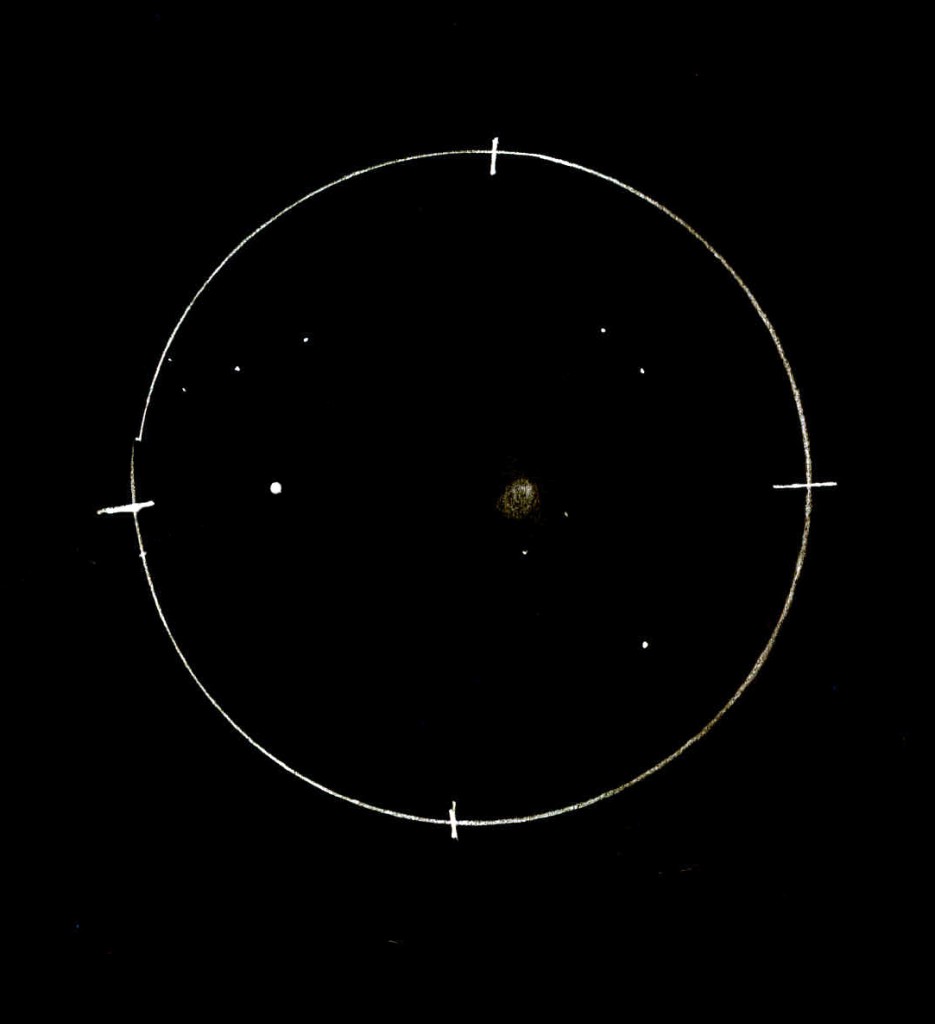
Object Name : M 28
Constellation Name : Sagittarius
Object Type : Global Cluster
Location : Saveh, Iran
Date : 29. September . 2011
Media : White paper , Pencil
Instrument : Binocular 20*80
By : Ghazale Adampour (zoole)
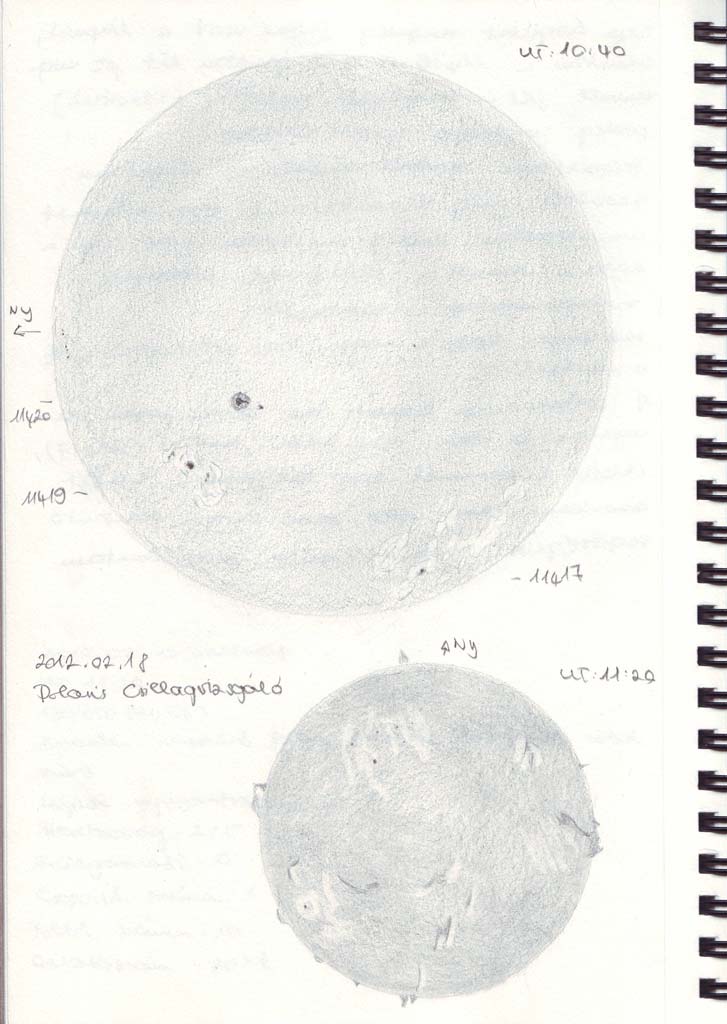
Dear Asod,
I send you hereby my sketch made this Saturday at Polaris Observatory, Hungary. I used a 114/900 Skywatcher with Baader solar filter for white light sketch and a Lunt 35 for the H-alpha sketch.
The most intersting part is a solar prominence on the northern edge, which is was a very 3D something, biting in the sun-disk.
Equipments used: 114/900 SW (100x) & Lunt 35/400 H-alpha
Date: 18th February 2012, UT: 10:40 (white light) and 11:20 (H-alpha)
Place: Hungary, Budapest, Polaris Observatory
Media: graphite pencil used on white paper
Clear skies,
Judit
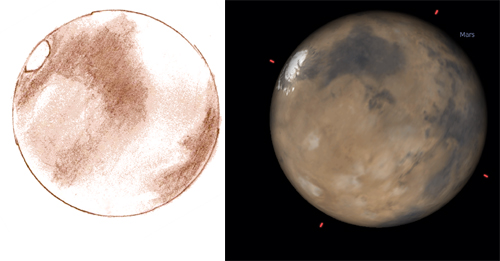
Object Name: Mars
Object Type: Planet
Location: Lombard, IL, USA, 41° 52′ 48″ N / 88° 0′ 28″ W
Date: 19 Feb 2012, 22:20-22:45 CST
Media: Pencil
Comments: This is Mars observed using my homemade 8″ f5.9 dob and Baader Hyperion 5mm, I had a pretty good seeing that evening. After scanning the picture, color balance was adjusted in Photoshop to better resemble observable Martian palette. The image to the right was generated by Stellarium for comparison.
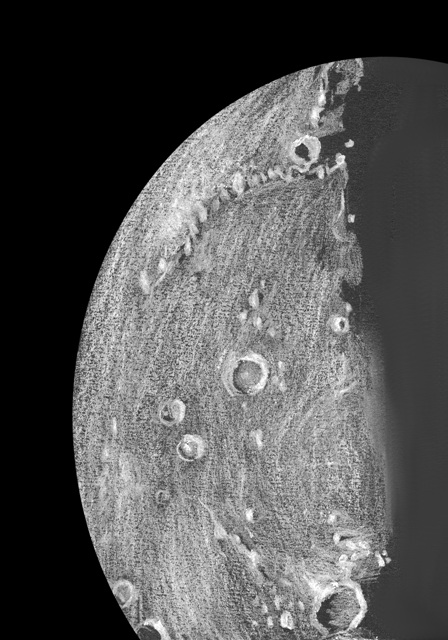
Hi,
I send my sketch of the Moon. The sketch was made on Aug. 25, 2012, by means of white watercolor and dry pastel. That night the moon was 8 days after the new moon. He was low on the horizon but still was strong in my telescope. This is my first picture of the moon.
GREETS
Date: 25th August 2012
Location: Pasry in Poland
Telescope: Newton 8 ”
Media: white watercolor and dry pastel, black paper
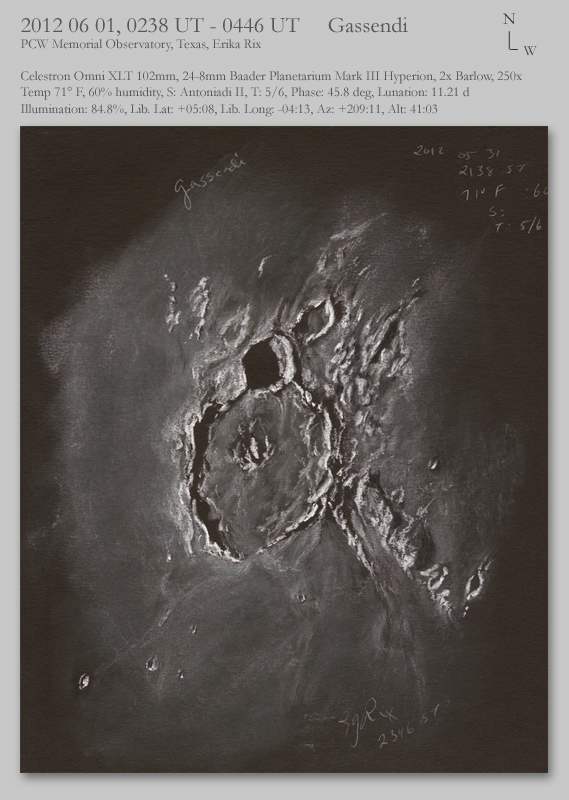
Gassendi Crater
Move cursor over image to view labels.
2012 06 01, 0238 UT – 0446 UT Gassendi
PCW Memorial Observatory, Texas, Erika Rix
www.pcwobservatory.com
Celestron Omni XLT 102mm, 24-8mm Baader Planetarium Mark III Hyperion, 2x Barlow, 250x
Temp 71° F, 60% humidity, S: Antoniadi II, T: 5/6
Eyepiece sketch black Strathmore Artagain paper, Conte crayon and pastel pencil, charcoal pencil
Phase: 45.8 deg, Lunation: 11.21 d, Illumination: 84.8%
Lib. Lat: +05:08, Lib. Long: -04:13
Az: +209:11, Alt: 41:03
Located on the northern border of Mare Humorum, crater Gassendi is an impact crater formed during the Nectarian period (-3.92 to 3.85 billion years ago) that later was modified after volcanic activity, becoming a fractured-floor crater. Gassendi is believed to have been filled with lava from the inside, raising its floor, creating stress fractures in the process. This would explain it being considered a walled plain with a shallow depth of 2.8 km. The central peaks (~1200 m high) remain and several rilles (called Rimae Gassendi) were formed on the lava-filled floor during the Imbrian geological period -3.85 to –3.2 billion years ago.
Crater Gassendi A was formed during the Copernician period (–1.1 billion years ago to the present day) and overlaps Gassendi’s northern rim. The pairing of Gassendi and Gassendi A resembles a diamond ring and makes a very striking feature to observe 3 days after first quarter or two days after last quarter of lunation. My observation was nearly three days after first quarter.
Gassendi’s southern rim was swallowed by the lava of Mare Humorum leaving only a thin crest line to support its circular shape. Dorsa ran from the southern rim to Gassendi O (11 km wide). The sharp ridge that defines the border of Mare Humorum to the SW of Gassendi adds to the crater’s unmistakable identification.
At the beginning of my session, Spica and Saturn lined up to align with the Moon. Spica was 2.08 degrees north of the Moon and Saturn was 6.9 degrees north of the Moon. Extending further north, Arcturus was nearly in line as well at 31.8 degrees north of the Moon
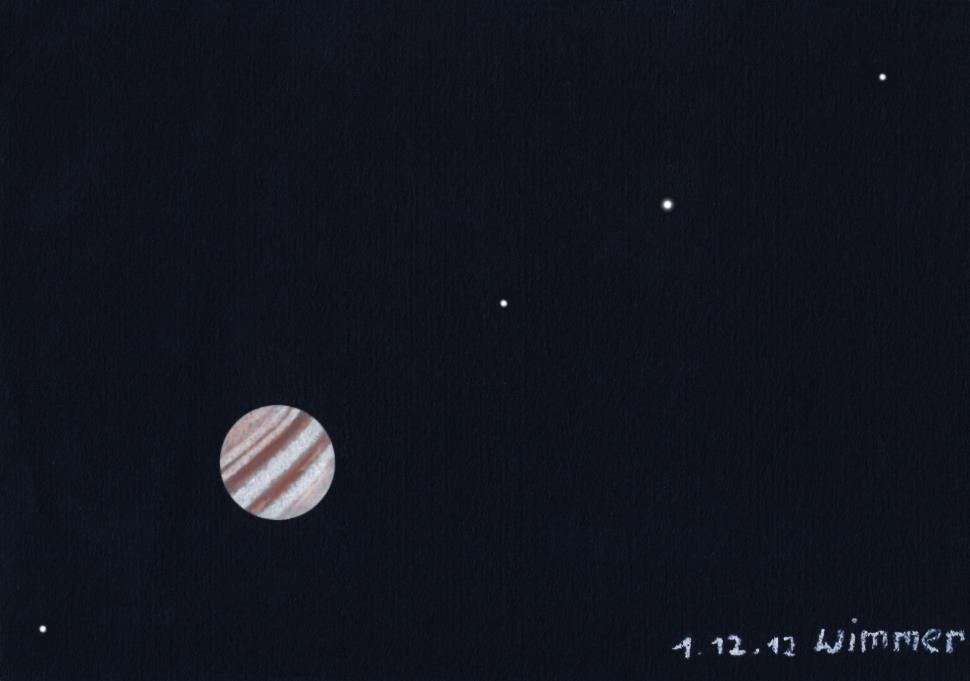
Hello!
I present to you my latest sketch of the Jupiter.
Sketch was made by pastels on the navy blue paper and it is also some corrected with GIMP (especially the roundness of the planet).
Jupiter was observed through my SCT 5″ on December 1st, 2012.
Best regards!
Aleksander Cieśla (wimmer)
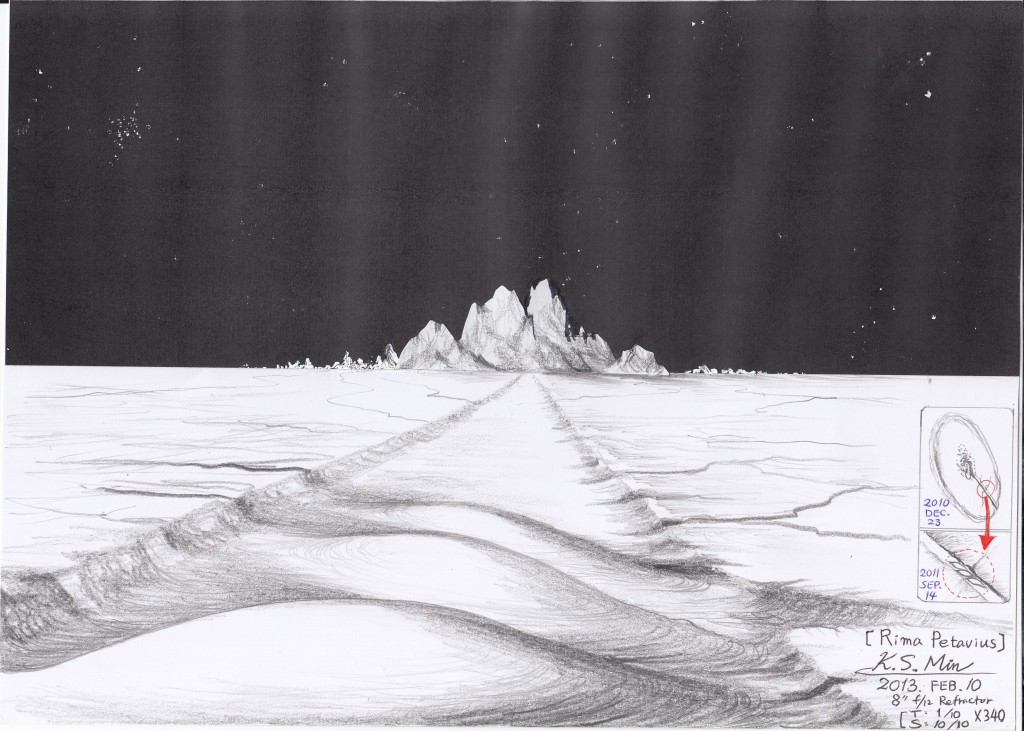
I have observed rima Petavius several times .
One exellant seeing night, 2011. 9[september] .14 …. , I ,d found out with my 8″ refractor at x 340 the three tuna-fish like convex hills on the middle of the 80 km long rima road,,,
I was then feel very happy because maybe this discovery was the first since amateur lunar observing history.
I have made this artistic conception today, a Lunar horizon landscape viewed from on one of the the three [Tuna-fish like hills] which located on the bottom of 4 km wide, 80 km long magnificent rill.
I dont know how many billions of years have passed on this geological creation,formation, or evollution forces- sequences.
—————–
8 inches refractor x 340, homade equatorial
date; 2011. sep. 14
location; at backyard home in South korea
media; graphite pencils , a white A4 printer paper
tranceparency; worst, 0.5-1/10
seeing ; perfect, 10/10
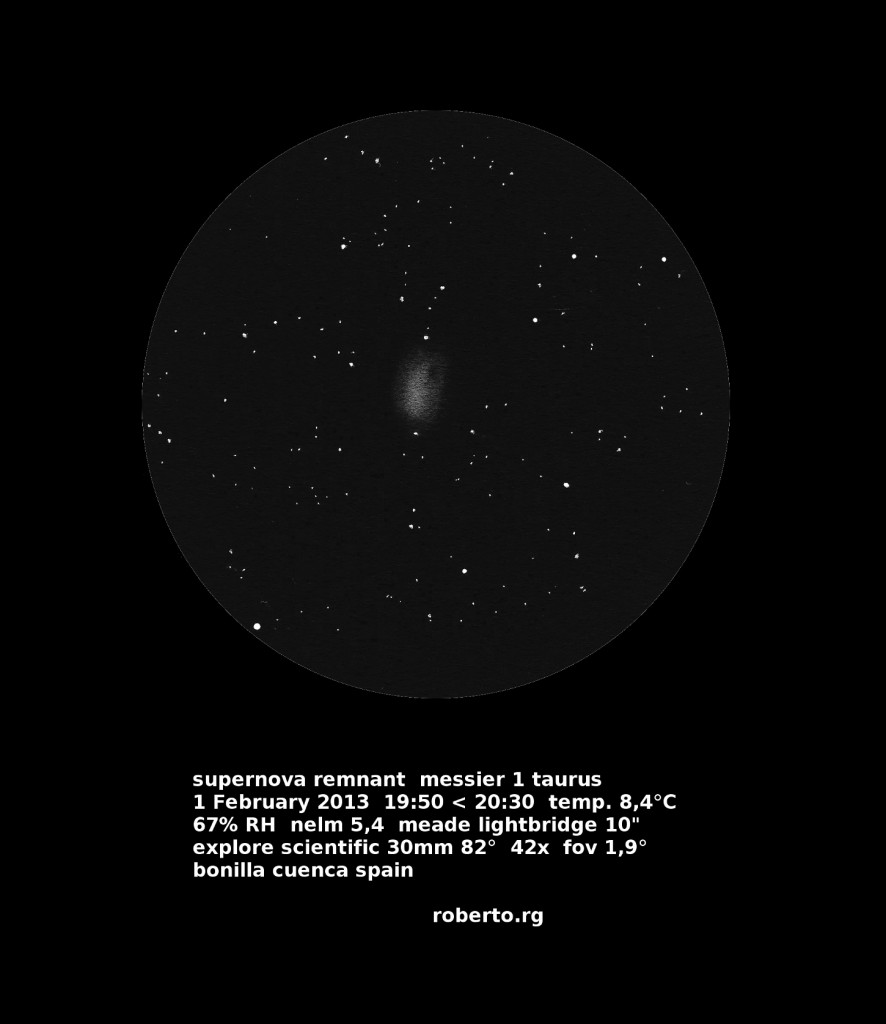
hi asod,I send my last observation of the Crab Nebula.this day the sky seemed to be good, but later was completely clouded wind.with these bad conditions, I was pleased with the observation.greetings and thanks.
Object Name: messier 1 / ngc 1952
Object Type: supernova remnant
Location: bonilla cuenca / spain
Date: 1 February 2013 hour 19:50 < 20:30
temp. 8,4° C humidity 67% nelm 5,4 bortle scale 3/9
Media: Canson 130g paper,graphite pencil,and gimp tools 2.8
optical equipment: meade lightbridge 10'' & explore scientific 30mm 82°
42x increases fov 1,9° 6mm exit pupil